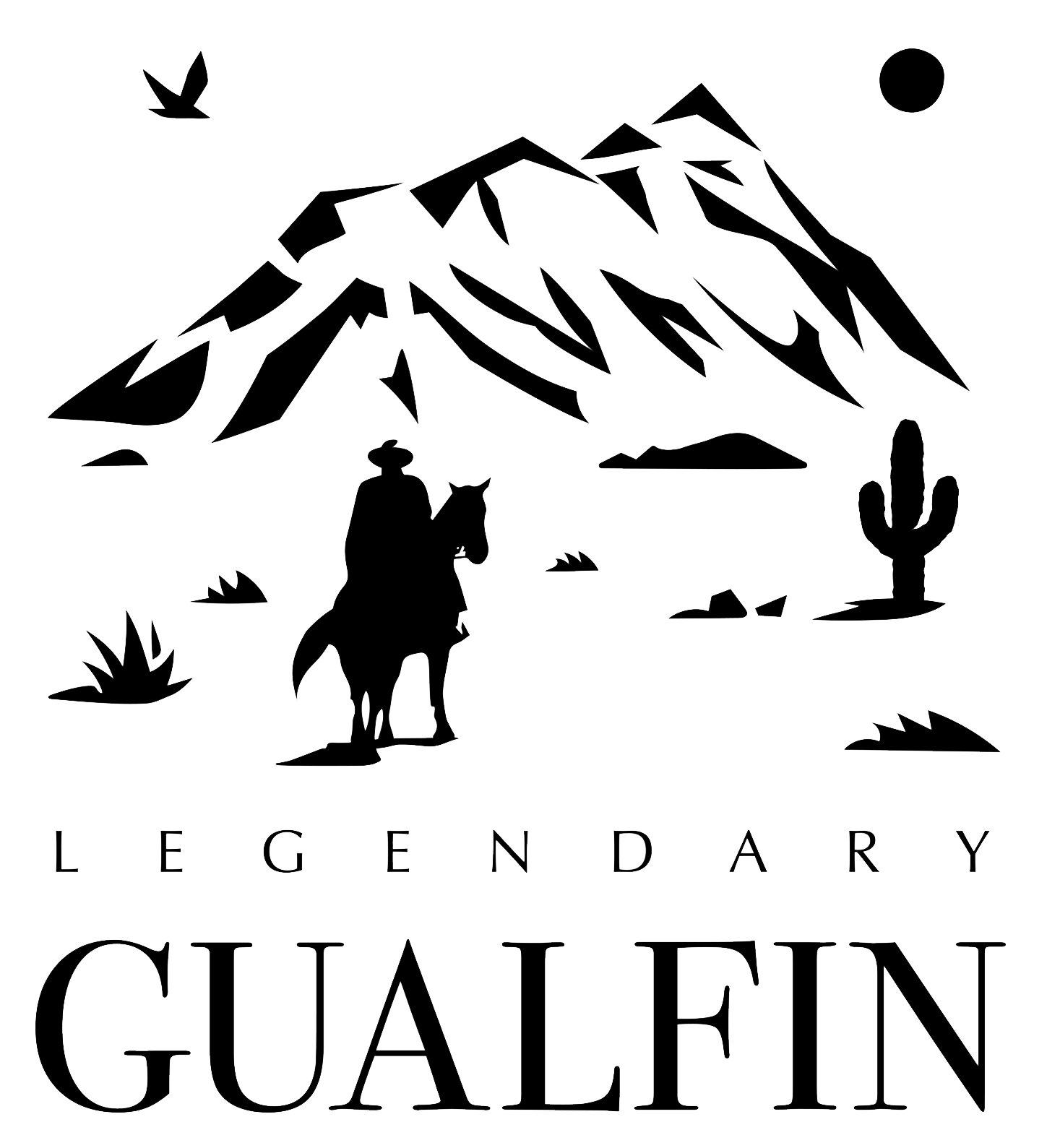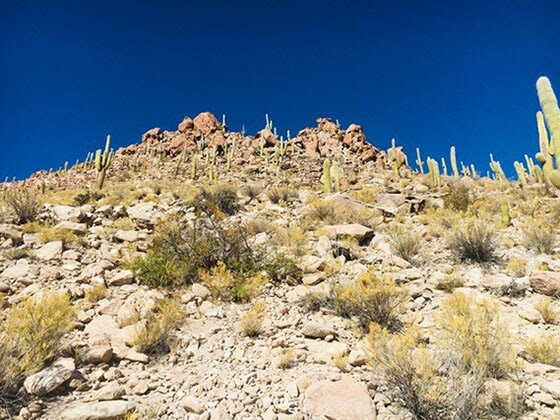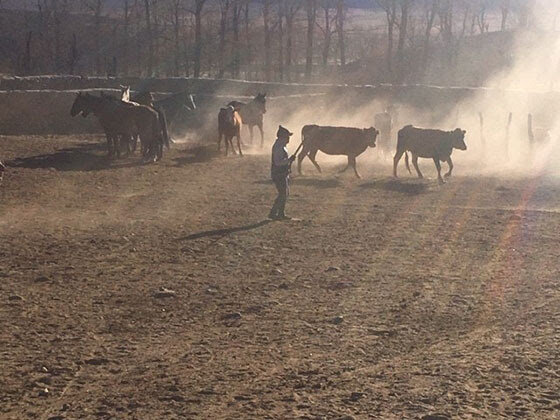Hard, Dangerous Work
Week 18 of the Quarantine
GUALFIN, ARGENTINA – Work began at 8 a.m. It’s midwinter here. And at 9,000 feet, the mornings are ice-cold.
Then, the sun crests over the Durazno mountain to the east, and it warms up fast.
We’re here rounding up the cattle… and then testing each one. Those not pregnant will be herded over the pass and down into the valley, where we have rolls of alfalfa to feed them… and some bulls ready to greet them.
With any luck, their health will improve… the bulls will do their work… and they’ll come back in the spring ready to have healthy calves.
Originario War Update
But we interrupt our work to bring you an update on the Originario War.
Last night, just as the sun was setting, there was a knock on the door.
There, a man – about 60 years old, dark skinned, walking with a limp… and a woman with a small face and fine features… both wearing heavy coats – appeared in the half-darkness.
“Are you the owner? Are you the boss?” asked the man.
“Yes…”
“Well, you’re the one I need to talk to. You’re the law here. You need to set things right. And I know I can count on you.”
“I hope so. What’s the problem?”
“Someone killed one of my cows on your property… and I know who did it. One of the originarios.”
To bring new readers into the picture, a few years after we arrived here in Argentina – nearly 15 years ago – we began hearing about the “originarios.” They are local people who claim that since their ancestors once owned the land, they should get it back.
It’s a little like the claim of the Black Lives Matter group in the U.S., who think that because they had ancestors who were enslaved, they should get a larger slice of the pie, regardless of who actually baked it.
Here, the originarios have taken over two of our valleys. In one of them, they burned our two cabins (where the farmhands stay when they are working the cattle in the valley) and destroyed the corral where the animals are tested, inoculated, tagged, castrated, branded, and sorted.
A few weeks ago, we rode up to the valley to see the burnt-out houses… and called the police.
The Fortress
Then, this Saturday, we decided to check out the other originario stronghold.
“I don’t know, Boss,” said our farm manager. “You better let someone go with you. We haven’t had any personal violence yet. But you never know. I’ll ask Samuel to go with you.”
There is no road to the valley – the Quebrada Grande – just a trail. The idea was to ride up to visit the originarios (cordially… no point in making things worse… but showing that we have not abandoned the valley)…
…and then to go up to visit a landmark – the Fortress. At the end of the valley is a small mountain. At its top, the pre-Columbian tribe that lived in the valley had built stone walls, which must have served as a castle keep… the last refuge of the tribe.
On our ranch were the Gualfines Indians… Over the mountains was another tribe, the Tacuiles. Further south were the Jasimanes… the Tolombones, and so forth.
Most likely, they warred with each other… with the home team using the Fortress as an ultimate redoubt.
Occasionally, they had to face “foreign” conquerors, too. One hundred years before the Spanish conquest, for example, the Inca had turned the locals into vassals and built a small town or storage post not far from here.
Like the Pena Punta mesa that we explored in May, the Fortress would have been almost impossible to take by force. But like the mesa, it has one big problem – it has no water.
Affectionate Nicknames
So, we set out with Samuel. We rode through one pass… then along the “main” track up into the mountains, until we veered off to the west, crossing the river at the bottom… and then headed back over another pass.
Samuel leads the way
At the top of this second pass – about an hour and a half into our journey – we saw that this area had once been heavily inhabited. There were telltale terrace walls everywhere. Some time in the past – archeologists say it was about 500 years ago – the climate must have been a bit wetter. The Indians terraced the hillsides in order to hold the precious earth and water.
From the pass, we continued on down into the valley.
“Boss,” Samuel explained the layout, “there are four farms down there. Over to the right is Gerardo. You know him. He’s okay… but he goes along with whatever the others are doing.
“Then, back there,” Samuel pointed to a far corner of the valley… very pretty, with several pastures and rows of Lombardy poplars lining the water canals, “that’s where Maria La Gorda [Fat Mary] lives.”
In America today, you wouldn’t dare refer to a woman as “Fat Mary.” But people in this part of the world have their own codes and customs. Fat Mary is fat; so they call her Fat Mary. Another woman has a limp, so they call her “Gimpy.”
One of our employees is called “Rat,” for unknown reasons. His son is referred to as “Ratoncito,” or the little rat. Another is known as “The Turk,” again, for reasons no one can remember.
As far as we can tell, these nicknames are affectionate, not disrespectful.
Powerless
But returning to Fat Mary…
“Do you know what she did?”
We did know, but we wanted Samuel to explain it.
“She told me that I couldn’t come into the valley… and that if I did, she was going to tell the police that I had raped all the women.”
“Even Fat Mary?” we asked, with mock surprise.
Samuel laughed.
“Yes… So I went to the police and told them about her threatening me. I don’t know what good it does…”
We rode down into the valley. No sign of anyone. No one working in the fields. No smoke rising from the chimneys.
We had decided to be pleasant to anyone we met. But we began to doubt that that was the best policy. What if we met one of the Chailes, whom we believe burned down our houses? Shouldn’t we at least ask if they had done it… and why?
“Don’t bother,” was the advice from Samuel. “They already told the police that they had nothing to do with it. You’ll just show them how powerless we are to do anything about it.”
Previous Visit
The Chailes’ farm has about 50 acres of bottomland. We own it, on paper. But we have no control over it… and get no rent from it. From a distance, it looks neat… almost idyllic, but dry.
A stone corral on one side of the river had about six horses in it. On the other side were pastures and small fields of corn, which had been harvested not long ago.
We recalled that we had passed over the same trail about 13 years ago, with our old farm manager, Jorge, and two of our sons. But things were different then. That was before the originarios had risen up in open revolt.
“Jorge kept things under control,” Samuel explained. “Nobody wanted to get too far out of line, mostly out of respect for Jorge. He’d been here all his life. He was fair. People trusted him. And he was related to almost everyone.”
But the proto-originarios were already causing trouble. Back then, we rode up to the house… and stayed on our horses.
“We know you’re in there… come on out…” Jorge yelled.
There was smoke rising from the chimney. We knew someone was there… and we knew, too, that the Chailes were using water when they weren’t supposed to.
Water is precious. There is a system to share it, where everyone gets a turn. Not respecting the system is like cattle-rustling. People have been shot for less.
After a few minutes, a young boy came out. Surly. Shy. Jorge told him he wasn’t supposed to be using the water. He took a rock and placed it across the offending canal… and went back into the house.
“It’s almost impossible to control,” said Jorge. “You get people you can’t trust up here… And there’s not much you can do. In the old days, you would have burned down their houses and run them off the ranch. But you can’t do that anymore.”
Back then, 13 years ago, people still pretended to respect each other’s rights. Now, they don’t even pretend. The Chailes claim it is their land and they can do as they like with it.
Jorge retired and is now living comfortably in the city. He must have seen even more trouble coming. The young boy we met on our last visit is now in his 20s. He is one of the prime suspects in burning down our cabins… as well as rustling and killing our cattle.
Folktale
On Saturday, again, we sat on our horses. But there was no smoke rising from the chimney and no need to yell. There was no one home. From one end to the other, the valley seemed to be empty. Horses grazed in their fields. Cattle and sheep, too.
But we saw no people.
We rode on through the valley to the Fortress.
The Forteleza
There, we dismounted, tied up the horses, and climbed slowly up the hill. The Indians had erected walls. But many of them had fallen down. So, too, there were protected spots, like caves, in between the boulders… where the Indians must have sheltered from the wind and the cold.
All around there were pottery shards.
“The Indians made this their last stand,” said Samuel. “Maria (Jorge’s wife, the former school mistress) brought us here when we were children. She explained it to us.
“The Spanish had invaded the valley. The Indians took refuge here and tried to wait them out. But they ran out of food and water… they threw down their pots…
“…and some committed suicide by jumping off the cliffs. But that might be just a folktale.”
Ranch Work
Meanwhile, back at the ranch, yesterday, we helped with the cows. Each one needed to be checked, which required a team effort.
The herd had already been penned up.
Your editor’s job was to hustle along the top of the wall, beating a stick against the stone beneath him and yelling…
“Y…aaa…haaa.”
(Sometimes, for variety, we yelled “Y…aaa…hooo…” But after extensive testing, we found that “Y…aaa…haaa” was more effective.)
The combination of noises, not to mention a grown man standing atop a 7-foot-high wall, was intended to frighten the cattle from the holding pen into the chute where, one by one, they would get worked over.
The animal would head into the narrow chute and see a way out at the other end. But when she almost reached freedom, Sergio would come down hard on the long wooden arm that controlled the head lock. A second later, Pedro had her clamped in the middle with his body lock. The cow struggled and complained… but once properly locked in place, it was a hopeless cause.
In the headlock
Seeing the animal under control, the veterinarian slid a further block into the chute to prevent the cow from kicking him. Then, he stuck his right arm, sheathed in a plastic glove, into the cow’s rectum…
It took him only a few seconds. He then withdrew his arm and made his declaration.
“Little” or “big” meant the cow was pregnant, and described, in rough terms, the status of the fetus. Otherwise, he would say “empty.”
These words determined the cow’s fate. A pregnant cow would stay at the ranch. An “empty” one would go down to the farm for fattening up… and natural insemination.
Pedro would then grab the cow’s tail and hack off the hairs at the end, which tend to pick up thorns.
Meanwhile, Gustavo examined the cow’s teeth. Up here, with so little grass, cows grind down their teeth on the sandy dirt. After a few years, they can no longer eat. If the cow’s teeth were too worn, Gustavo yelled out “CUT”… and attached a blue tag to the cow’s ear, meaning this will be its last calf.
Dangerous Work
The work is fairly routine… And with the rise and fall of the levers that control the locks, it’s almost mechanical… like a primitive machine with wooden valves operated by farm hands.
Working the Chute
But something always goes wrong. A cow panics and breaks the locks. Or she tries to turn around in the chute and gets stuck. Or someone gets careless and gets crushed by a cow.
This morning, when we arrived at the corral, we found a big swirl of dust and chaos.
A ruckus at the corral
One of the cows had gotten mad and began attacking both the horses and the farmhands. The gauchos took it as good fun… trying to get a lasso on the frantic beast… and laughing as they ran for their lives.
But they eventually got the animals into the holding pen and were able to go to work.
Finally in the holding pen
The cows rarely mean any harm. But they are large animals with horns, and they are sometimes almost mad with fear. And when things go wrong, someone almost always has to jump down into the chute to try to straighten it out.
In the most alarming instance, yesterday, a cow that had tried to get out had fallen back on her back. There, confined between the two stone walls of the chute, she couldn’t get up. Her eyes bulged and then rolled back in her head as if she were dying.
It seemed like an impossible situation. She was fully grown. There was no way we were going to lift her up. And getting close to her at all was an invitation to a broken bone.
She kicked with her hooves and flailed about with her maddened head. And as long as she stayed where she was, the whole process of checking the cows was at a dead stop.
But our capataz (foreman) had an idea. While we tried to prevent the other animals in the chute from crushing him, he got down into the narrow passage and quickly put a rawhide lasso around the cow’s front feet.
Then, a heavy wooden pole was laid across the top of the chute, and the lasso looped over it, so that we could pull on it and raise the animal’s forequarters. While all of us pulled on the rope, he attached a nose clamp to raise the cow’s head.
It was like raising an obelisk… but it worked. The cow was pulled up into a sitting position. And then, she righted herself completely, as we all scrambled out of her way.
“Happens all the time,” said the vet.
At Day’s End
The work was hard. The dust, the wind, and the thin air made it unpleasant at times. And by the time the sun set, we were all exhausted.
We closed the gates, trudged back up the hill to the farmhouse, lit a fire to warm ourselves… and prepared for dinner.
But the day was not over. It was then that we heard the knock on the door.
More to come…
Regards,
Bill






